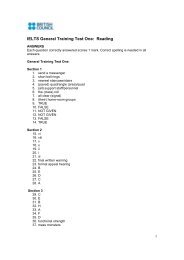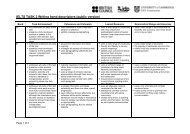IELTS Academic Module preparation > Writing ... - Take IELTS
IELTS Academic Module preparation > Writing ... - Take IELTS
IELTS Academic Module preparation > Writing ... - Take IELTS
You also want an ePaper? Increase the reach of your titles
YUMPU automatically turns print PDFs into web optimized ePapers that Google loves.
Activity 6<br />
c)<br />
The diagram shows how someone can find their exact location anywhere in the world by means of<br />
the Global Positioning System (GPS). The system has three main segments: the space segment,<br />
the control segment and the user segment.<br />
The space segment consists of 24 satellites which are put into orbit at an altitude of about 20,000 km.<br />
Each one takes 12 hours to orbit the earth once. They have solar panels which provide power and<br />
antennae in order to receive and transmit data. Each satellite continually transmits a coded message<br />
which includes information about its position and the exact time of transmission. The satellites are<br />
fitted with atomic clocks so that time is kept with great accuracy.<br />
The control segment consists of a number of monitor stations at different locations on Earth and a<br />
main control centre in Colorado, USA. Any slight changes in the orbit of the satellites can be<br />
detected by the monitor stations. This information is then sent to the control centre, and from here it<br />
is transmitted back to the satellites. Consequently, the satellites can always transmit their exact<br />
position to users.<br />
The user segment is basically a handheld receiver capable of picking up signals from the satellites.<br />
The receiver compares the time a signal was sent with the time it was received. As a result, the<br />
distance between the user and the satellite can be calculated. By taking similar measurements from<br />
four satellites, the receiver can pinpoint the exact location and altitude of the user on Earth.<br />
Activity 7<br />
1d type 4; 2b type 3; 3a type 2; 4c type 1<br />
Activity 8<br />
1 Apart from wasting huge amounts of water, industries are responsible for the contamination of<br />
water supplies.<br />
2 Contrary to the popular belief that machines have replaced skilled workers everywhere, there are<br />
many skilled artisans in China and other Asian countries.<br />
3 Despite billions of dollars in aid having been sent to developing countries, millions of people in<br />
developing countries still live in absolute poverty.<br />
4 While people claim to show concern for the environment, they compromise their ecological values<br />
almost daily.<br />
5 Not only is there an epidemic of obesity amongst Western adults, but obesity is becoming<br />
widespread in Western children.<br />
Activity 9<br />
Paragraph 1:<br />
(TS) There is, of course, a human factor involved in road safety. (D1)Most road accidents are caused<br />
by careless and irresponsible driving. (D2) Drivers who exceed safe speed limits, for example, cause<br />
many accidents. (D3) In addition, drivers often overtake when it is not safe to do so, such as on sharp<br />
bends. (D4) Finally, many road deaths are due to people driving when under the influence of alcohol.<br />
(R) These are just a few examples of how human error or recklessness can lead to tragedy on the<br />
roads.<br />
Paragraph 2<br />
(TS) Have the recent rapid developments in communication technology made the world a better<br />
place? (D1) It is sometimes said that modern technology has helped create greater understanding<br />
between nations. (D2) However, there is little evidence to support this view. (D3) Although technology<br />
such as the Internet has increased the ease and speed with which people from different countries<br />
communicate, there still exist misunderstandings about each other’s cultures and beliefs. (D4) For<br />
example, people seem to be no closer in their understanding of faiths other than their own. (R)<br />
Communication technology may have the potential to improve the world, but we have not yet<br />
exploited that potential to best effect.<br />
Page 14 of 15







